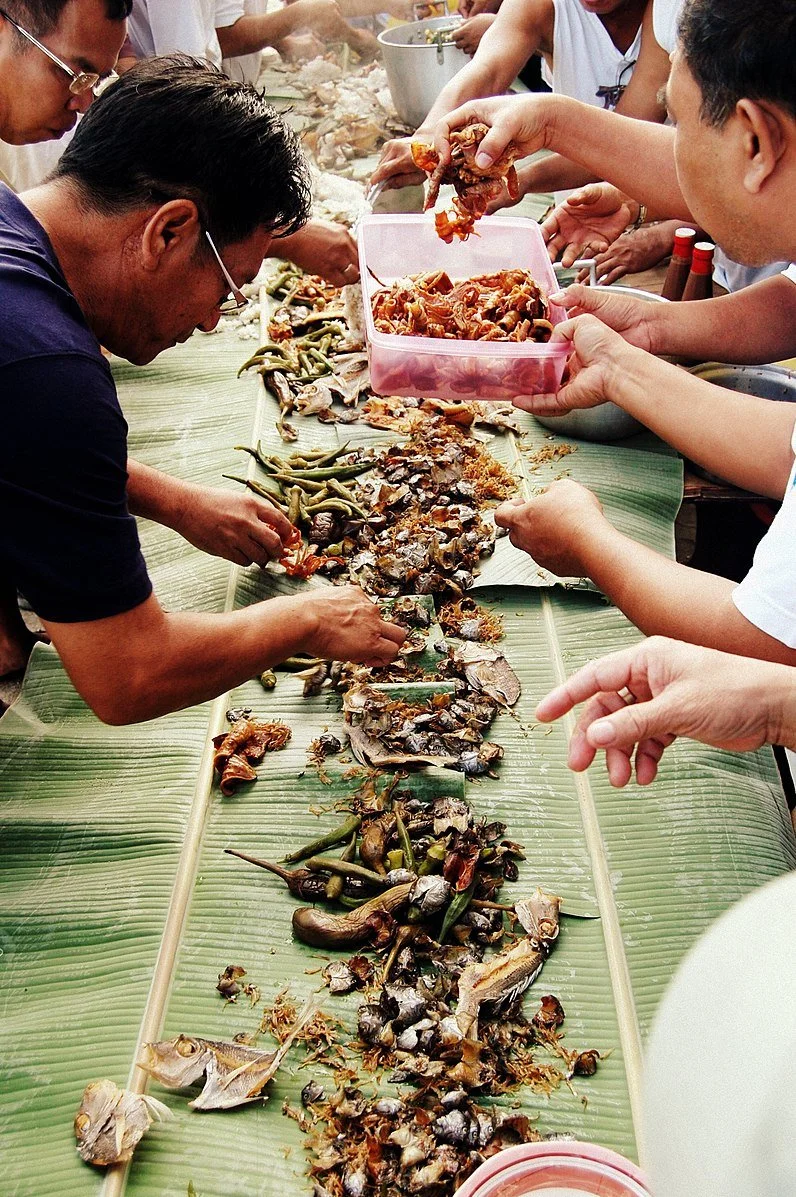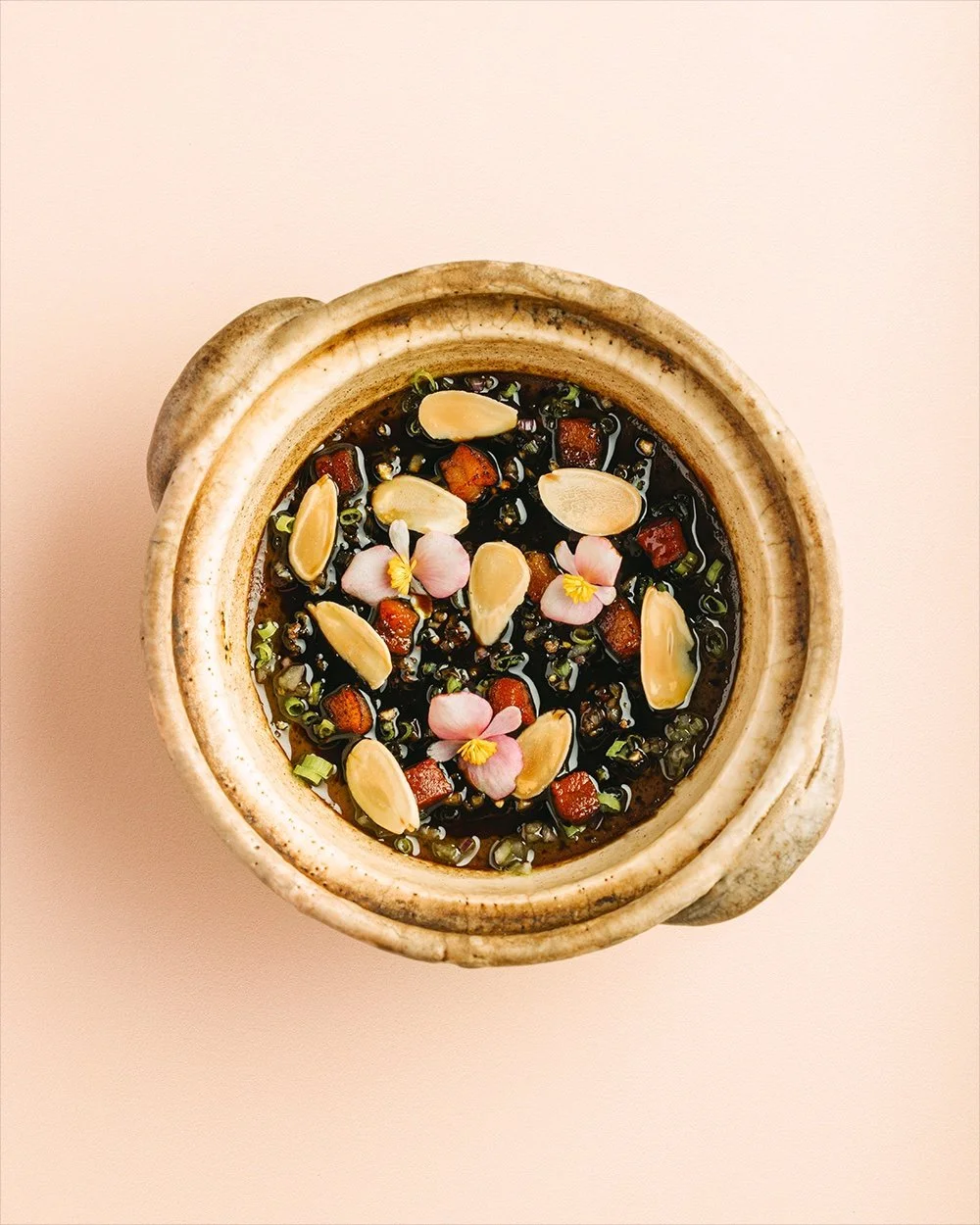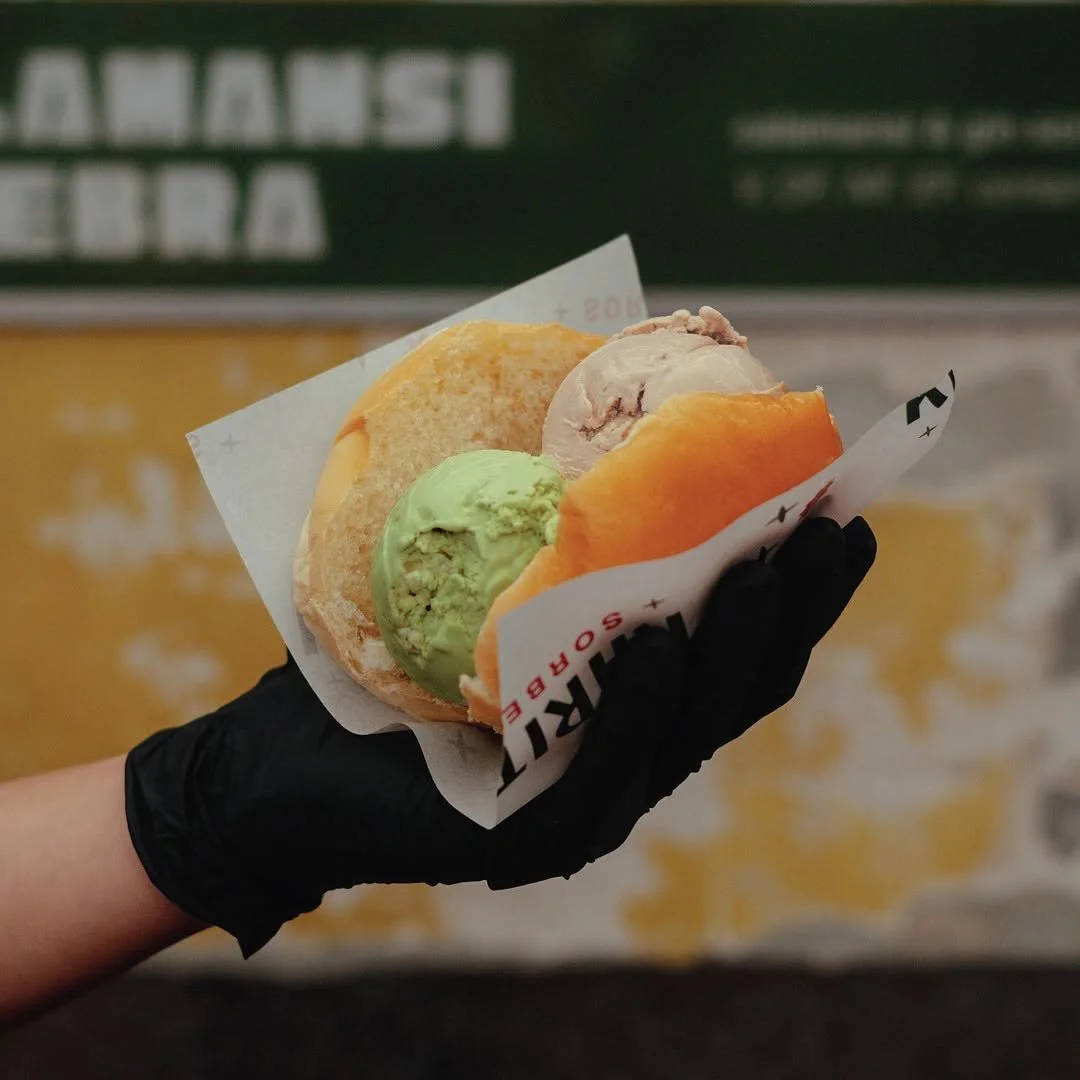Filipino Cookbooks Don’t Sell
Photograph: A roadside fruit stand in the Philippines. Credit: Maysie Lecciones.
Filipino cuisine has long existed at the edges of mainstream recognition: rich, complex and often misunderstood. Now, a new generation of hospitality professionals, activists and creatives are reclaiming its power, not by translating it for the West, but by telling their stories on their own terms.
By Rushani Epa.
When I was eleven, I attended my best friend’s birthday party in Melbourne’s eastern suburbs. Her Filipina mother had prepared a vibrant spread that joyfully bridged two worlds: sausage rolls sat beside crispy lumpia, fairy bread nestled alongside steaming trays of pancit. A group of pre-pubescent girls, we congregated on the floor and consumed the film Thirteen, until her mother entered the room to offer us something unfamiliar: dinuguan, a rich, dark stew of pig’s blood tempered with vinegar. The room grew quiet. Some girls recoiled; others giggled nervously. I caught a flicker in her mother’s eyes. Was it hurt, or simply recognition?
At that age, I didn’t yet grasp what I was turning down. I lacked the vocabulary for shame, colonisation or culinary erasure, but I knew how she felt having experienced that same pang before: in the school yard clutching onto a Thermos of rice and curry, or when friends visited my Sri Lankan household. Years later, working in publishing, I’d hear an echo of that moment when someone confidently informed me: “Filipino cookbooks don’t sell.”
How do you define a cuisine from more than 7,600 islands, countless languages, and hundreds of variations on a single dish? Filipino food is often said to be “having a moment,” as if it hasn’t always been present, in suburban garages, balikbayan boxes filled with cans of Spam, jars of bagoong, crispy chicharrón, and the comforting scent of pandesal bread fresh before school drop-off.
“It’s crunchy then soft, sweet then savoury, constant push and pull. Like art, it's not realism; it's hyperbole. The collision is the magic.”
Filipino cuisine did not simply appear. It has always been here, and I've returned to it consciously as an adult: licking the fat from lechon off my lips at birthdays in Melbourne backyards, watching tangy adobo bubbling gently on kitchen stoves, treating myself to Filipino crispy fried chicken from a local chicken joint in Melbourne’s west, and sampling crisped-up balut on a bed of soy caramel at a friend’s restaurant.
“It’s always been there,” agrees John Rivera, chef-owner of the contemporary Filipino restaurant Askal and artisanal gelateria Kariton Sorbetes. “The question is: who’s been paying attention?”
For generations, homestyle Filipino food lingered at the margins, lovingly served at family tables but rarely invited into mainstream dining culture. “Filipino food suffers from misrecognition,” explains photographer Luisa Brimble. “People don’t know how to describe it without comparing it to something else. Adobo becomes stew; lumpia becomes spring rolls, everything simplified to suit Western palates.”
Brimble encountered this firsthand in a meeting with a major publisher, an experience she recounted candidly in her Substack essay titled The Extreme Push-and-Pull of Filipino Food (And Why It Changes Everything). “It made me feel small,” she wrote. “The untold truth, the unspoken energy. That this book was ‘too niche.’ That at the end of the day, it wouldn’t sell, because I wanted to write this book for Filipinos—and no ‘white ladies’... would ever understand what I’m about to share with you.” Her words resonated deeply with diaspora creatives, quietly validating what many already knew: their stories were only acceptable if made easily digestible for the white gaze.
This pressure to simplify Filipino food for the West traps it in an inescapable cycle. But speak to anyone raised with it, and you’ll hear passionate descriptions of extremes: sour sinigang soup, crisp yet melting lechon kawali, pungent vinegars, and breakfasts of bold fragrances. “There’s no middle ground,” says Brimble. “It’s crunchy then soft, sweet then savoury, constant push and pull. Like art, it's not realism; it's hyperbole. The collision is the magic.”
***
The Philippines’ is not without a brutal colonial past, first through Spanish conquest, then American rule, followed briefly by Japanese occupation. Yet even before colonisation, the islands thrived as a trading hub influenced by Chinese, Malay and Arab merchants. Colonisation imposed religion, surnames and class distinctions, labelling the Filipino tradition of eating with hands as “uncivilised.”
But its ancestral knowledge extends far beyond recipes. Lechon, often credited to the Spanish, actually originates from indigenous Filipino spit-roasting methods largely forgotten in mainstream narratives. Hospitality expert Jessa Jastrzemski, formerly of Alain Ducasse and La Dame de Pic, now working with Spanish winery Bendito Destino, emphasises overlooked culinary practices. “Everyone mentions Spanish influence first, but nose-to-tail cooking, fermentation, rice cultivation: those are deeply Filipino practices.”
“Colonisation made us ashamed of eating with our hands,” says chef Yana Gilbuena-Babu, founder of the Salo Series, a culinary project that took her across all 50 US states offering kamayan-style dinners served without cutlery on banana leaves. “Even today, some Filipinos look down on it. Kamayan, for me, is resistance.”
Photograph: A kamayan feast, also known as a boodle fight. Source: Creative commons.
Gilbuena-Babu’s dinners began from a longing for a comforting bowl of arroz caldo on a cold New York night. Unable to find it available online, she realised the dominant American narrative surrounding Filipino food barely resembled home.
Chef Miko Calo, originally from Butuan City, is making waves in the fine dining scene. Similarly to Gilbuena-Babu, she challenges Western culinary framing: “Even how we describe flavours is colonial. Wine notes cater to European palates: stone fruit, limestone, green apple. But what if I taste soy sauce or overripe pink guava in Chardonnay? My perception isn’t wrong; our references simply differ. Why should one perspective be considered more correct?”
“My parents arrived speaking thick-accented English, mocked for their mispronunciations. Now others are learning our words. It’s a subtle but profound shift.”
Calo constantly thought of home during her years cooking in Paris where she mastered French cooking techniques. “That instinct, craving the flavours of my childhood, guided me,” she says. “Filipino food is as layered, as technique-driven as any other cuisine. We simply haven’t documented it in the same way.” At Manila’s Makati Shangri-La, Calo now transforms dinuguan into a black pudding, steamed smooth in bamboo and garnished with sugar cane vinegar, toasted almonds, edible flowers and etag: salt-cured, smoked pork belly from the Cordilleras.
Photograph: Miko Calo’s boudin and etag. Source: Pol Divina.
Rivera deliberately uses native language on his menus, such as ube instead of purple yam, or balut rather than fertilised duck egg, recognising the power embedded in those words. “People told us Australians would mispronounce ‘Kariton’ and ‘Askal.’ That’s exactly the point,” he explains. “My parents arrived speaking thick-accented English, mocked for their mispronunciations. Now others are learning our words. It’s a subtle but profound shift.” Gelato became Rivera’s approachable medium, introducing Australians to distinct Filipino flavours like kalamansi and pandan.
Photograph: Kariton Sorbetes.
British celebrity chef Gordon Ramsay once called the Philippines “the sleeping beauty of Asia,” and the late American chef and documentarian Anthony Bourdain claimed Filipino food would have "a really bright future" in the States, both underscoring its immense yet largely untapped culinary potential in the West. Visibility is slowly growing, embodied by global Filipino brands like Jollibee, originally an ice cream parlour founded by a Chinese migrant. Now a fast-food phenomenon, Jollibee popularised the American hamburger in the Philippines, yet is perhaps best known for its sweet spaghetti, flavoured uniquely with banana ketchup, a creation by pioneering Filipino food scientist Maria Orosa, born from necessity to address import shortages.
Yet visibility remains complicated. The Michelin Guide’s recent arrival in Manila and Cebu prompted mixed reactions. “Thailand invested in culinary tourism decades ago,” Calo says. “Now people travel there specifically to eat. We haven’t cultivated that yet as we need to first focus on strengthening supply chain infrastructure and supporting agriculture before focussing on Michelin. I’m hoping that the arrival of Michelin will help in finding solutions and support.”
Neglect extends beyond tourism and government-led initiatives to Western institutions. When publishers say Filipino cookbooks don’t sell, it’s not content failure but a failure of imagination, a refusal to invest in a cuisine that resists being flattened. The issue isn’t the food but who defines what’s marketable or authentic.
Authenticity itself is contentious. “Even within adobo, there are hundreds of variations,” Gilbuena-Babu explains. Calo agrees: “We’re not a monolith.”
**
“The West needs to hear these stories. Flavours and histories at risk of disappearing can only be accessible if we pay attention.”
Filipino culinary advocacy spans the globe. In Australia, groups like the Entree. Pinays and the Filipino Food Movement fiercely champion diaspora representation; while Filipina powerhouses like Marjorie Tenchavez ardently support refugees and asylum seekers via Welcome Merchant. In London, chef Florence Mae Magnaloc uses her venues, Donia Restaurant and Panadera Bakery, to blend nostalgia with innovation, reinterpreting traditional dishes for modern diners. Cultural trailblazers like Doreen Fernandez, Felice Prudente Sta. Maria and Amy Besa have long documented the richness of Filipino foodways, writing against the grain, insisting that their cuisine deserves serious study, not just spectacle.
Contemporary cookbooks by Filipino voices amplify this global shift: Alvin Cailan, founder of iconic LA egg-burger and sandwich chain Eggslut, pens Amboy: Recipes from the Filipino-American Dream; food writer Arlyn Osborne shares her identity through Sugarcane Sweet: Recipes from My Half-Filipino Kitchen; blogger and baker Abi Balingit of the Dusky Kitchen reinvents desserts in Mayumu: Filipino American Desserts Remixed; journalist Yasmin Newman paints vibrant portraits of island feasts in Under Coconut Skies; and chef and activist Angela Dimayuga explores identity and cuisine in Filipinx. Impossible to overlook is the iconic Margarita Forés, a culinary luminary whose recent passing leaves a profound void.
Yet amid this bright cultural momentum lies the quiet fragility of tradition. The Philippines, one of the world’s largest coconut exporters, holds stories of abundance alongside narratives of risk and erasure. “I recently discovered this remarkable salt called tultul from Guimaras, the island in Iloilo where my mother grew up,” Jastrzemski recounts. Made from salt cooked and compressed with coconut milk, tultul was once crafted by over a hundred artisans; today, just one or two remain. “Because Margarita Forés fiercely supported those artisans, the tradition survived. The West needs to hear these stories. Flavours and histories at risk of disappearing can only be accessible if we pay attention.”
Gilbuena-Babu frames this work as preservation and renewal: “I’m moving away from ‘decolonise,’ which has become trendy and diluted. Decolonisation is intentional, hard work; but only the first step. Next comes re-indigenisation: reconnecting, relearning and carrying ancestral knowledge forward. It’s empowerment, healing, confidently bringing ancient wisdom into the present.”
“One of the hardest tasks,” Rivera emphasises, “is making the case for why a place like Askal matters. There’s a lingering, class-rooted assumption in the Philippines that ‘high-end’ Filipino cuisine must cater exclusively to elitism. But my ambition is to prove that our food deserves equal footing with global giants like Italian, Japanese, or Thai. We should proudly own our culture, flavours, and history, refusing to cheapen or diminish ourselves. We have earned the right to flourish.”
Filipino food hasn’t suddenly appeared; it has always existed, a symbol of Filipino perseverance, resistance and pride, now proudly stepping forward and claiming its rightful place at the global table.
Join us for Salu Salo at Askal on Monday, April 7, hosted by Bendito Destino, Askal, Another Bottle and Colournary. This one-night-only event is more than just a wine dinner; it’s a celebration of Filipino heritage, identity and evolution. Meet Terry Kandylis and Jessa Jastrzemski, the powerhouse duo behind Spanish wine label Bendito Destino, and celebrate her Filipina roots alongside their innovative winemaking style. Sample six of their wines, paired alongside a bespoke five-course menu by Askal, offering Filipino flavours through a contemporary lens, curated by John Rivera (Kariton Sorbetes, ex-Amaru, Sunda, Lume). Book here.




